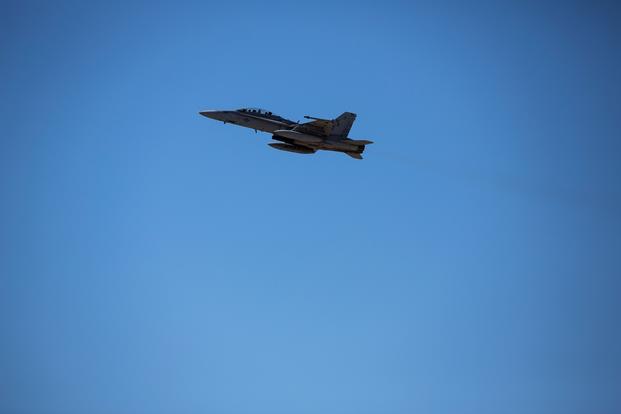Decorated Marine fighter pilot Maj. Richard "Sterling" Norton was still pulling the trigger when his F/A-18 Hornet collided with the ground during a California training exercise, a command investigation into the incident revealed.
Norton, 36, was killed July 28, 2016, when his F/A-18C Hornet crashed during night training at Marine Corps Air Ground Combat Center 29 Palms, California.
The tragic mishap, the second deadly crash for the Miramar-based Marine Fighter Attack Squadron 232 in less than a year, appeared to be the result of a CFIT, or controlled flight into terrain, indicating that Norton, an experienced 20-year pilot and a strike fighter tactics instructor, did not realize a lower-than-usual dive had set him in a collision course with the ground.
The tragedy highlights the danger inherent in military fighter training -- nighttime strafing maneuvers, which Norton was performing at the time of the crash, are among the most risky -- and the many demands on a pilot's attention in the cockpit.
Marine pilots on every aviation platform have struggled to meet monthly flight-hour goals as the service engages in a well-documented effort to recapitalize its airframes, and Norton was no exception, according to the command investigation obtained by Military.com.
He had flown 11.4 hours in the previous 30 days; 28.3 hours in the previous 60 days; and 40.5 hours in the previous 90 days. The Marine Corps' aviation campaign plan recommends that F/A-18 Hornet pilots complete 15.7, 31.4 and 47.1 hours of flight for each respective time period.
He began the July 28 strafing exercise with eight hours of night flight in the previous six months, according to the investigation.
In an endorsement of the investigation, Marine Aircraft Group 11 commanding officer Col. William H. Swan said officials may never fully know what caused Norton's crash. He spoke of Norton as a peer in the aviation community.
"Having had the honor of serving alongside Major Norton, I saw first-hand his professional acumen," Swan wrote. "I can tell you he was a quiet professional whose strength of character, gifted ability, and natural leadership epitomized what we all aspire to be as Marine officers and aviators. This is now shallow praise; but a testament to the man, his family and his friends that enabled him to have such a positive influence on those around him."
On the night of the crash, the training mission profile required Norton to conduct diving attacks, including bomb delivery and strafing runs, on targets in the desert designated by two AH-1Z Cobra helicopters providing support. His Hornet was armed with 250 rounds of PGU-48 20mm high-incendiary ammunition; one GBU-16 1,000-pound Paveway II bomb; and two 500-pound BDU-45 practice bombs.
Having completed one bombing dive and one strafing run, Norton had initiated another dive for a strafing run. About 90 seconds later, his aircraft crashed, creating a fireball in the desert.
"Maj. Norton … had already begun planning how he intended to complete this dive and then return to Miramar with the gas remaining," the investigating officer found. "Additionally, he would have also been calculating how long he would need to pull the trigger to expend his remaining rounds. These mental calculations, while not causal, became the first of several distractors during Dive #3 that led to Maj. Norton being cognitively saturated."
Norton dived lower and faster on the third dive than he had on the second, investigators found. He began pulling the trigger some 1,100 feet lower to the ground, focusing on engaging his targets at his current speed of more than 550 miles per hour as pre-set voice warnings began to kick in.
A voice warning in the cockpit began to blare "altitude, altitude," as it had on the previous two dives, when he came within 1,900 feet of the ground. But as Norton dove lower, he apparently missed another warning sign: a visual "up" arrow indicating a need to gain altitude immediately.
A third warning, a verbal "pull up, pull up," command came on late, just a second before impact, because the system was programmed not to allow one verbal warning to interrupt another.
Norton responded to this third warning with a reaction time of .6 seconds, not fast enough to pull the aircraft out of danger.
By the time the fourth and most urgent warning, a siren, began, there was only a third of a second remaining before impact.
The investigating officer made few recommendations in light of the crash, but did suggest that the hard radio altimeter warning, the third to kick in, did not offer the pilot enough reaction time at its recommended setting of 800 feet.
The impact of the loss of Norton, a graduate of the Navy's elite TOPGUN fighter school, and a veteran of Afghanistan, is evident in Swan's statement in the investigation endorsement.
"I have no doubt his legacy of tactical expertise, dedication, humor, humility, and friendship will be felt in perpetuity," Swan wrote. "He certainly will be missed by all who knew him."
Norton's mother, Mary Vanderhoof, told The Santa Cruz Sentinel last September that he would be buried next to Maj. Taj Sareen, a squadron mate, friend, and fellow pilot who died in a Hornet crash near Royal Air Field Lakenheath, England, in October 2015.
-- Hope Hodge Seck can be reached at hope.seck@military.com. Follow her on Twitter at@HopeSeck.





























